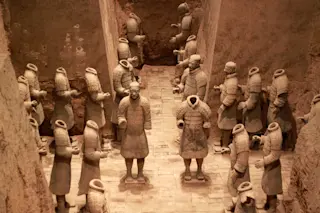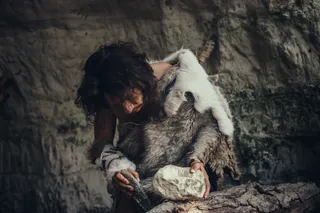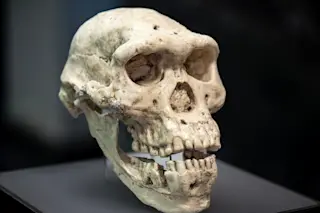Legends of setting foot in Qin Shi Huang’s tomb in Xi’an, China speak of booby traps — poison gases, trip-wire alarms and deadly crossbows. The crypt of the first emperor of China has been untouched for more than 2,000 years and has been a mysterious tomb for archeologists. But are those legends even true?
Some say the booby traps of Qin Shi Huang’s tomb are real. Some say they’re just a myth. Let’s explore the proof we can find.
Who Was Emperor Qin Shi Huang Himself?
Emperor Qin Shi Huang — of terracotta warrior fame — lived from approximately 259 to 210 B.C. Known for unifying China, building The Great Wall, and giving himself the title of Huangdi “Sovereign Sage Emperor,” modern China still takes its name after him (Qin is pronounced: “Chin”). But aside from that, Shi Huang is known for his magnificent and legendary tomb.
Many have heard the stories of untold riches, unimaginable wealth (and certain death) that await the brave souls who manage to breach the mysterious chambers of Shi Huang’s underground crypt. However, the tomb complex spans 3.9 square miles (6.3 square kilometers) and only the smallest percentage has been uncovered.
Read More: The 6 Most Iconic Artifacts From The Ancient World
While imagining the secrets that lie within, technicians at the funeral mound once told the newspaper El Pais, “It’s like having a present all wrapped at home, knowing that the very thing you want most is inside, but you can’t unwrap it.”
Historians and Qin Shi Huang’s Tomb
Most would agree that we can’t know for sure if the legends are true until the emperor’s grave is exhumed. But the great Han Dynasty historian, Sima Qian (145-87 B.C.), claims to have known.
As the best-known source of the booby trap legends, circa 94 B.C., Sima Qian wrote a clear and illuminating description of what lies beneath the 51.3-meter-high mound in his famous work, The Shiji:
“In the ninth month, the First Emperor was buried at Mount Li. When the First Emperor had just come to the throne, excavations and building work had taken place at Mount Li, but when he unified all under Heaven, convicts to the number of more than 700,000 were sent there from all over the Empire. They dug through three springs and poured down molten bronze to make the outer coffin; and replicas of palaces, pavilions, all the various officials, and wonderful vessels, and other rare objects were brought up to the tomb, which was then filled with them. Craftsmen were ordered to make crossbows and arrows which would operate automatically so that anyone who approached what had been excavated was immediately shot. Quicksilver [mercury] was used to represent the various waterways, the Yangtze and Yellow Rivers, and the great sea, being made by some mechanism to flow into each other, and above were arranged the heavenly constellations, and below was the layout of the land. Candles were made of whale fat [alternative literal translations: ‘mermaid ointment’ or ‘man-fish oil’], for it was reckoned that it would be a long time before they were extinguished.
Second Generation [Qin Shi Huang’s son] said: ‘It would not be right that any of the previous Emperor’s concubines should emerge from this place unless she has a son.’ They were all ordered to accompany him in death, and those who died were extremely numerous. After the burial had taken place someone mentioned the fact that the workers and craftsmen who had constructed the mechanical devices would know about all the buried treasures and the importance of the treasures would immediately be disclosed. Consequently when the great occasion was finished and after the treasures had been hidden away, the main entranceway to the tomb was shut off, and the outer gate lowered, so that all the workers and craftsmen who had buried the treasure were shut in, and there were none who came out again. And vegetation and trees were planted to make it look like a hill.” (Translation from Raymond Dawson, p. 83)
Thus, we find the source of the legends we know today. But Sima Qian wrote this description 123 years after the death of Shi Huang. Could his fantasy-like account of mermaid ointment (probably whale oil), flowing rivers of mercury, 700,000 laborers, crossbow booby traps and buried-alive workers be credible? Or is he just writing for effect?
Read More: The Terracotta Army: What These Life-Size Clay Warriors Tell Us About Ancient China
Historians certainly disagree when it comes to the veracity of Sima’s accounts. But there’s a small mountain of evidence that says he could be telling the truth.
Can We Trust Sima Qian’s Tomb Descriptions?
In her paper “Sima Qian: A True Historian?” Dr. Michael Nylan of University of California, Berkeley, says that one camp of historians celebrates the trustworthiness of Sima Qian by emphasizing “the extreme care with which Sima Qian gathered and weighed available evidence in an attempt to convey an objective portrait of the Chinese past.”
The other camp is more skeptical, stressing that there were “intensely personal motivations that prompted Sima Qian’s decision to complete the masterwork [of history] begun by his father […].” This more suspicious camp accuses Qian of exaggerating his accounts and being too much of a “lyrical romanticist” — too religious to convey an accurate depiction of history.
But in Nylan’s view, Sima Qian’s devotion to spirituality is an additional vote in favor of his truthfulness and objectivity. According to Nylan, even though Sima Qian did not have access to the historical knowledge we have today, we shouldn’t ignore the commitment he had to the truth by virtue of his religion.
Sima Qian believed that the spirits he wrote about — such as Qin Shi Huang — would bestow blessings upon him, but the blessings would hinge upon his ability to portray their histories accurately. Nylan also writes that throughout his works, Sima Qian was “insistent on the statement that he transmits the past and does not create,” and this humble approach further guided Sima Qian to be as historically accurate as possible.
Thus, Sima Qian had more than just a scientific commitment to objective history. He operated under a spiritual and religious obligation to the truth — because the truth was the only way he could invoke and receive the potent blessings of those he described.
The Terracotta Warriors
Another piece of evidence in Sima Qian’s favor was the 1974 discovery of 8,000 buried terracotta warriors. Until that discovery, many historians believed that Sima Qian was exaggerating when he claimed that 700,000 workers built Shi Huang’s crypt (seven times the number of men who built the Pyramid at Giza according to Herodotus).
Read More: An Underground Army: The 8,000 Terracotta Warriors
Nevertheless, the size, quality, and number of the terracotta statues seem to vindicate Sima from any claims of exaggeration. It now appears that Sima Qian was correct: Nearly a million laborers must have been involved in such a construction.
Clearly, no past is perfectly accurate, but if the 700,000 laborers were not an overstatement — and if Sima Qian maintained a religious obligation to the truth — at least we can assume that he didn’t embellish his reports of mercury, crossbows and everlasting mermaid ointment candles on purpose.
A Small Mountain of Evidence
The real evidence that Sima Qian was right lies beneath a small mountain of dirt waiting for future scholars to enter — if they dare to desecrate the resting place of the sovereign sage emperor, Huangdi.
Nevertheless, a 2020 scientific survey offers verifiable evidence that Sima Qian was right. Apparently, the tomb is saturated with mercury.
“Clearly, there are very large uncertainties in these estimations, but our findings add to the credibility of 2,200-year-old records by historian Sima on the existence of large amounts of mercury in the Emperor Qin tomb, also in view of estimates of the production capability of mercury at the times of Emperor Qin,” say the authors in the study.
Commenting on these findings, archeologist Qingbo Duan of Northwest University in Xi’an — who spent a decade leading excavations at the mausoleum — told Chemistry World that “the distribution of mercury level corresponds to the location of waterways in the Qin empire.”
In other words, the mercury appears to “simulate the hundreds of rivers, the Yangtze, the Yellow River, and the great sea”— just as Sima Qian had said.
The Mystery of Qin Shi Huang’s Tomb
Could the mercury still flow as depicted in The Shiji? Could the 'man-fish oil' candles still light the bejeweled and sparkling constellations on the ceiling? Could deadly, hair-trigger crossbows await the first person to enter?
To be fair, Qingbo Duan doesn’t believe that the tomb builders used mercury specifically as a trap for grave robbers — and Sima Qian never claimed it either — but after 2,000-plus years, the mercury in the tomb may have produced deadly and poisonous fumes. And if Sima Qian’s depiction of mercury is true, perhaps the threat of crossbows is genuine.
At the end of the day, we’re not going to solve the mystery of Huangdi’s tomb until someone breaks the seal. But even if we can’t know the truth for certain, we can still thank the spirit of Sima Qian for his marvelous and intricate descriptions, for his steadfast devotion to historical objectivity — and most importantly, for inspiring so many imaginations to fly for thousands of years, and many more to come. And seriously speaking, would you dare to be the first to enter the tomb of Qin Shi Huang?














